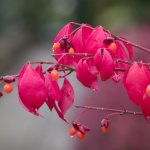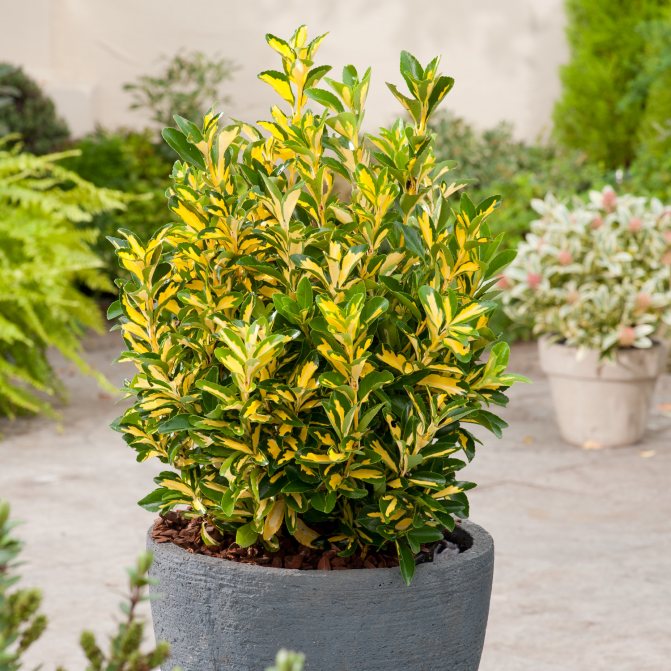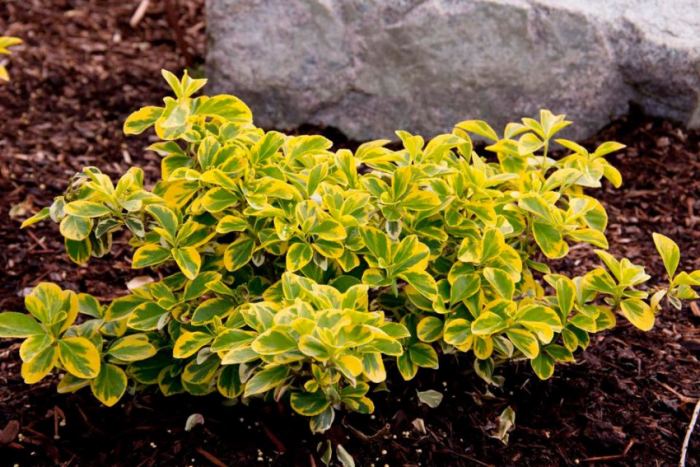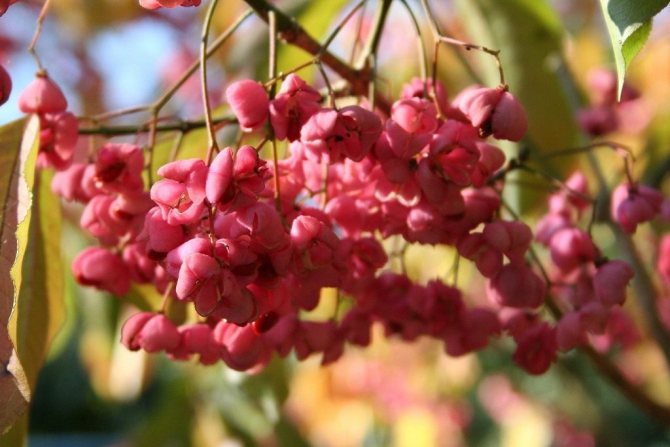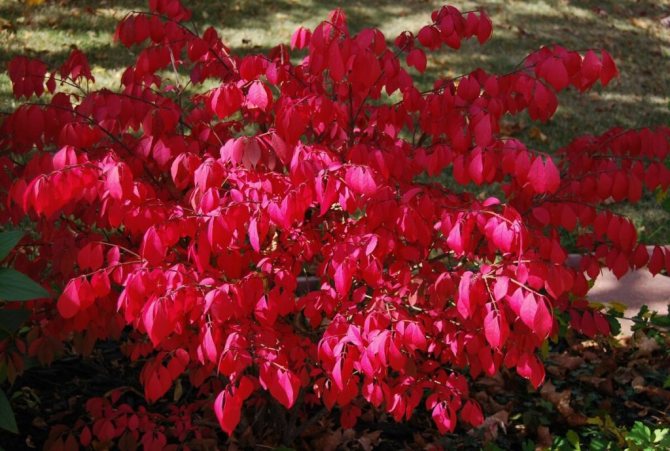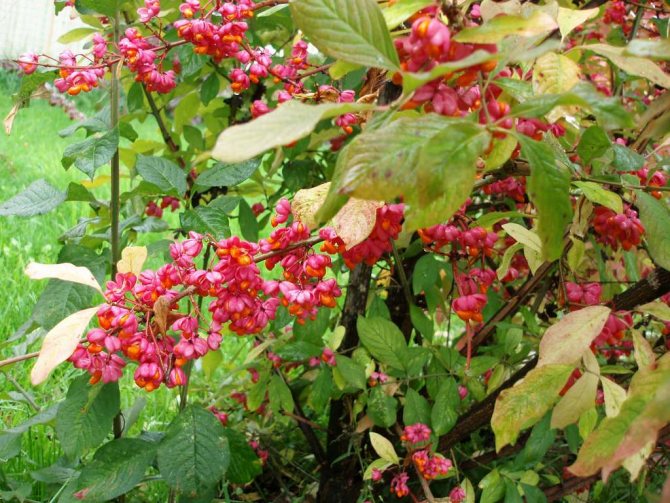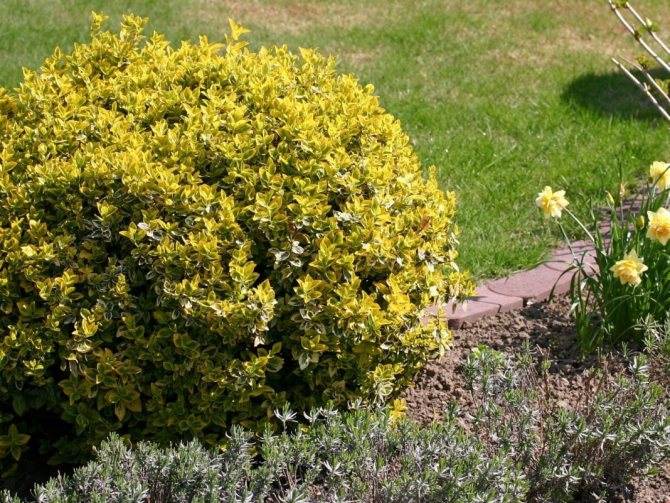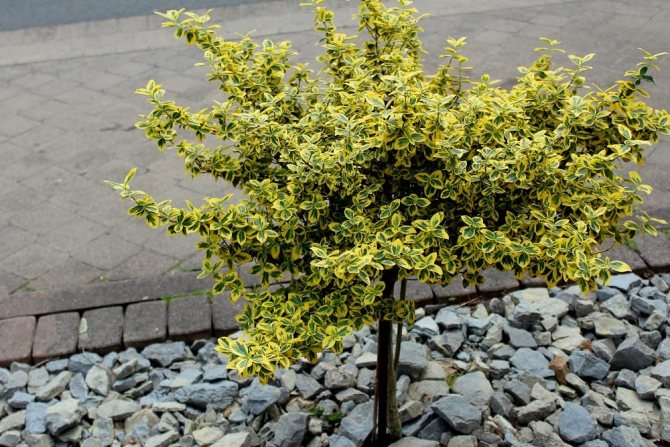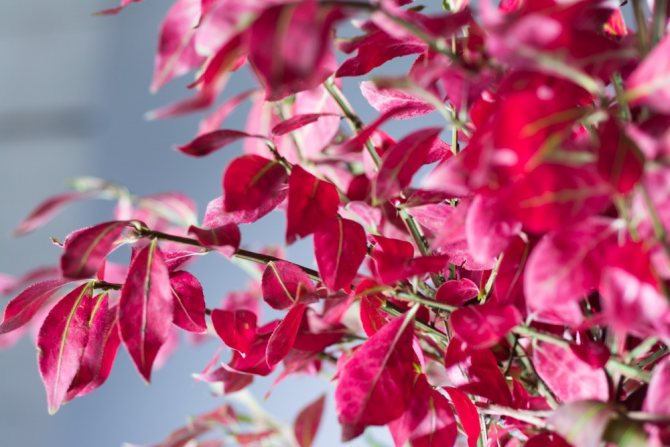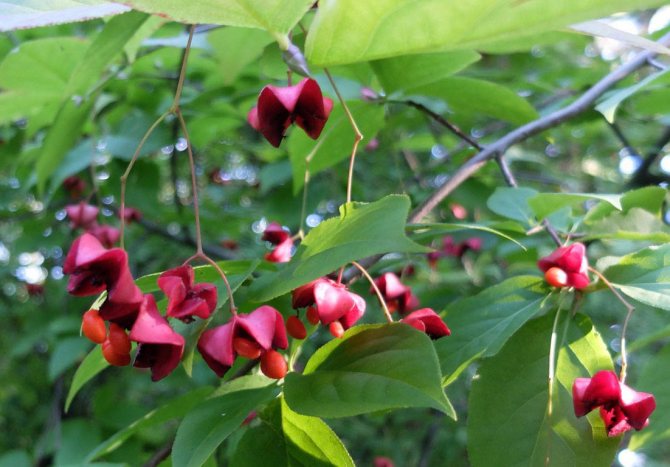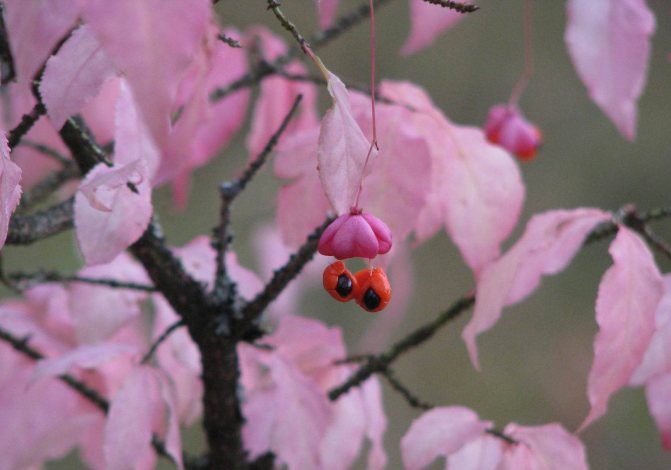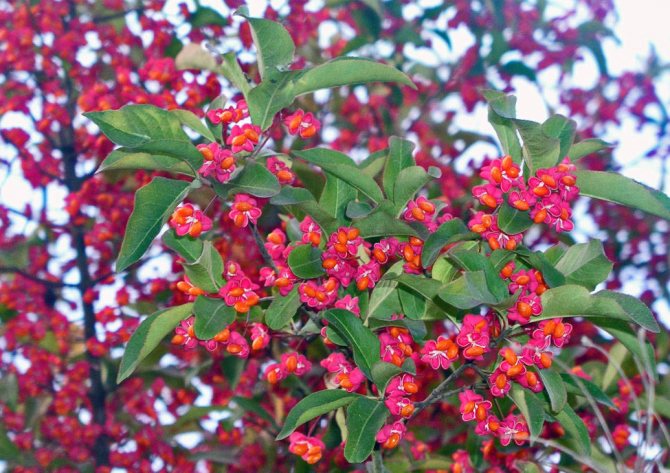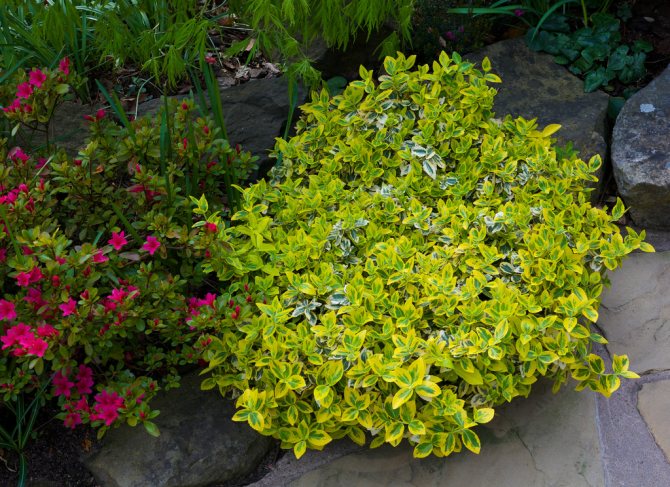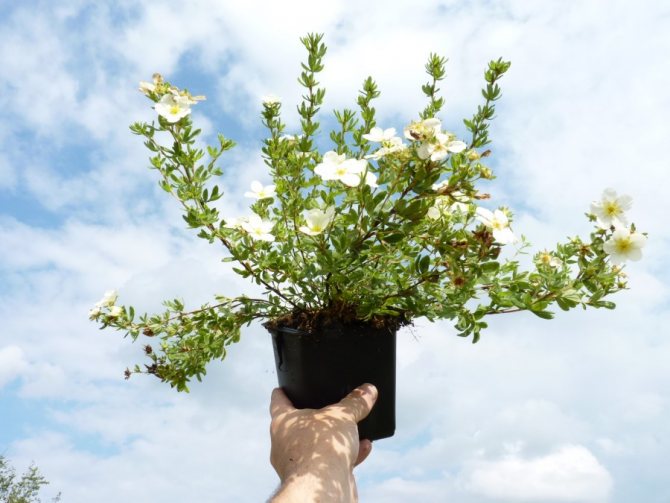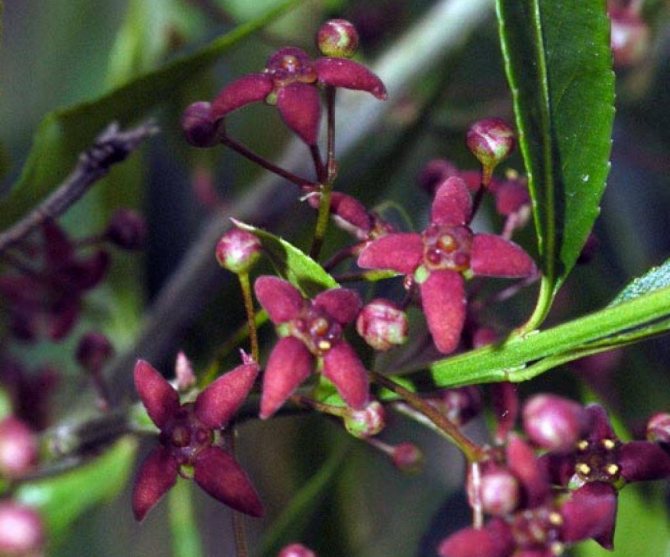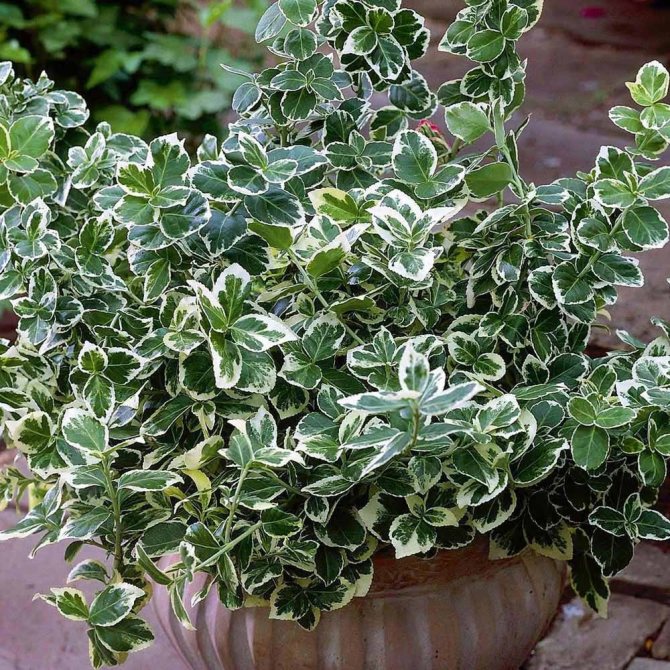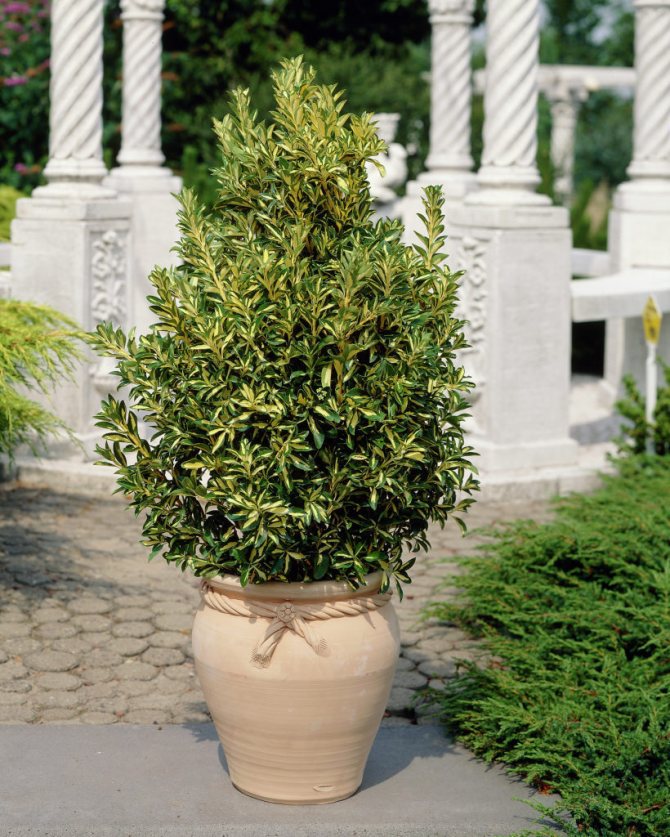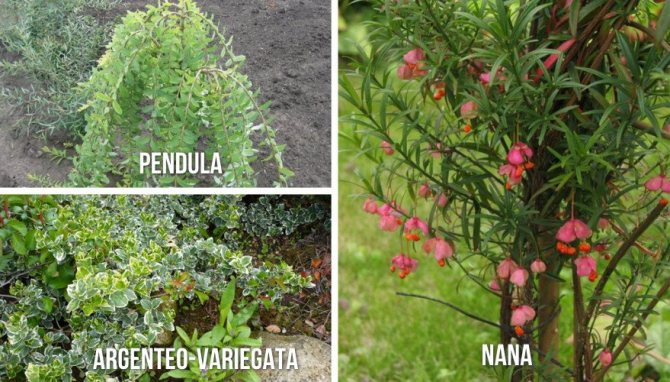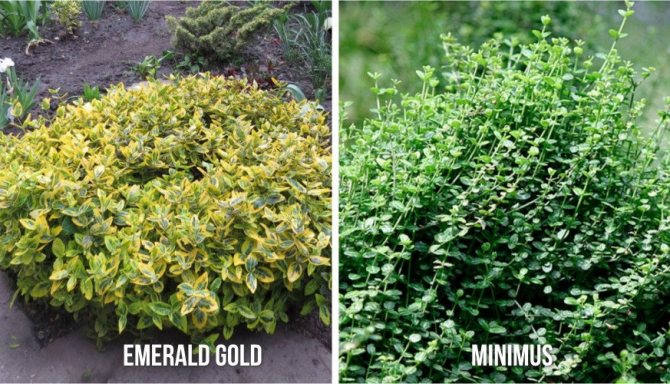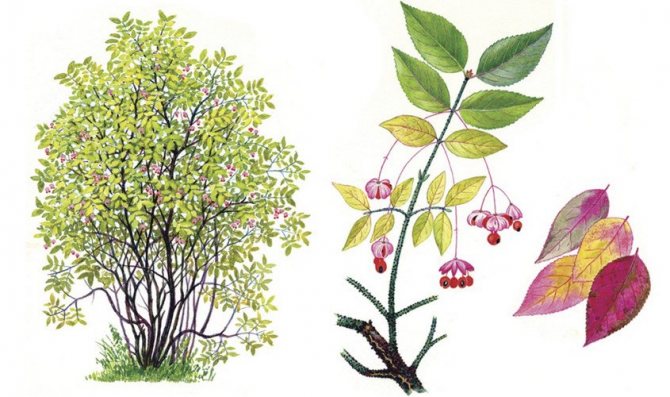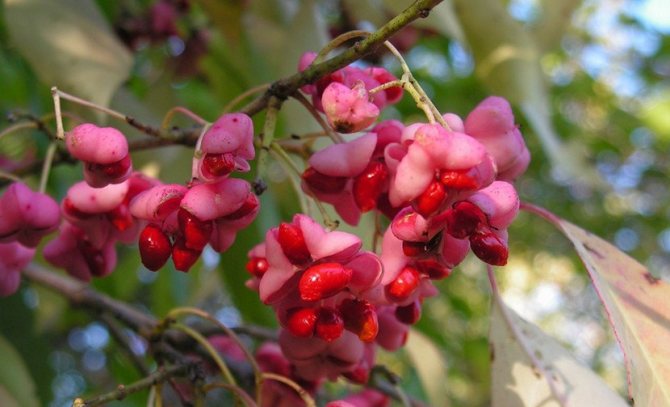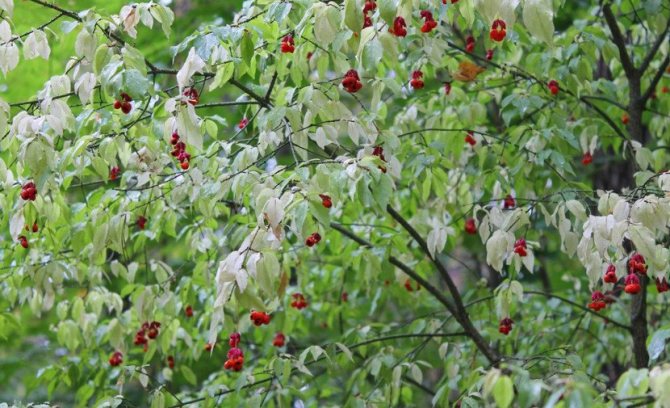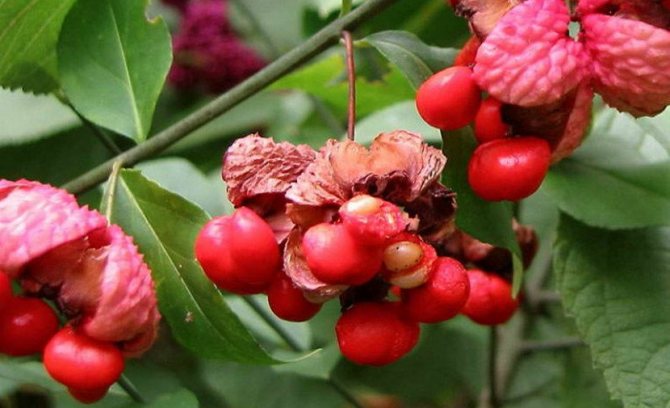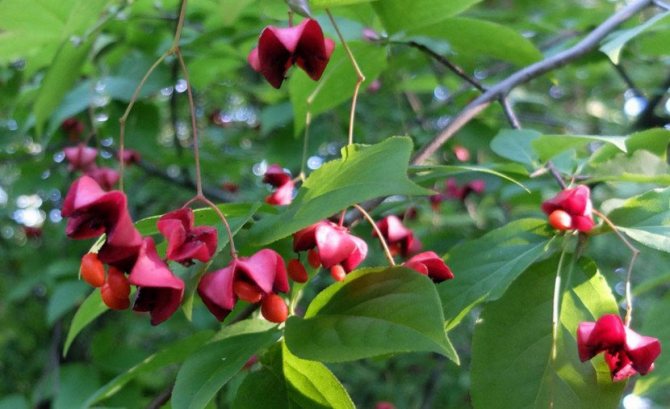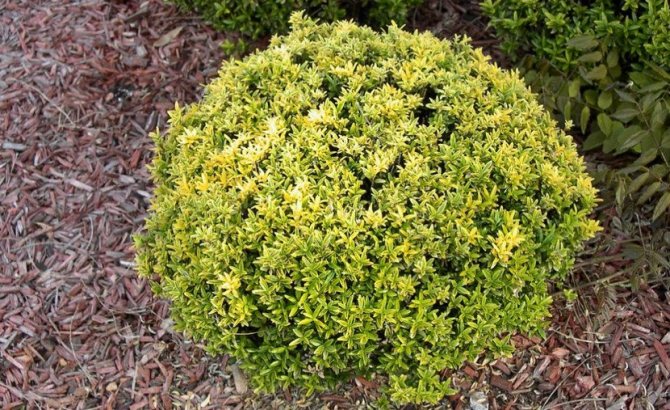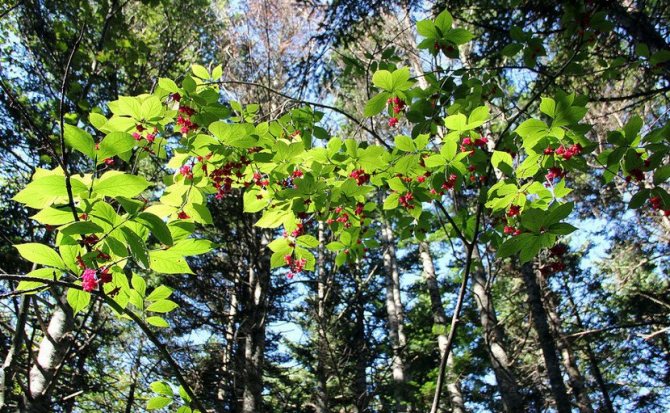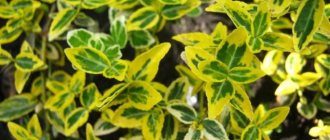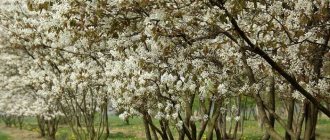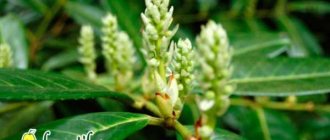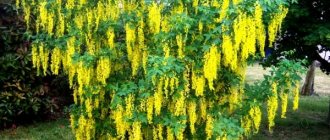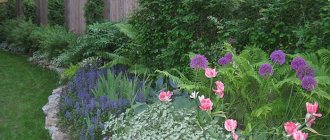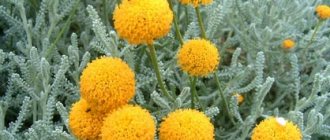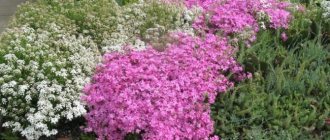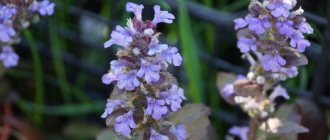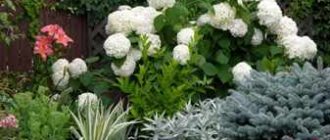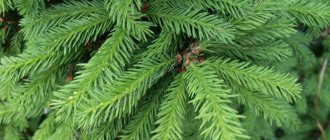Euonymus - deciduous or evergreen shrubs, as well as small trees of the euonymus family
The euonymus plant has more than 200 species and is distributed mainly in the Northern Hemisphere. It is cultivated more often as an ornamental plant, it is used in landscape design to decorate fences and alpine slides, it is also found in indoor content.
Euonymus shrubs are popular with gardeners and landscape designers.
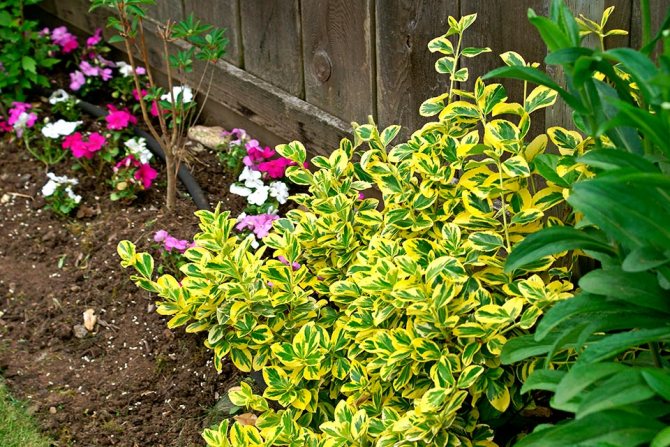
The variegated euonymus leaves look amazing
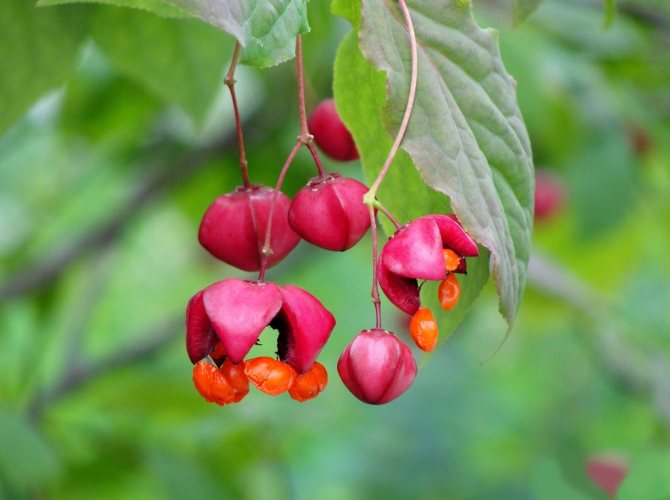

An elegant euonymus tree will decorate a personal plot not only in summer, but also in autumn
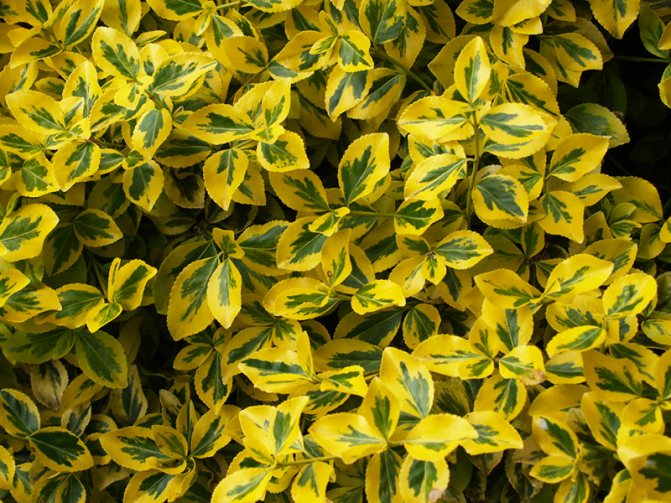

Fortune eonymus Emerald Gold
Large-winged euonymus (Euonymus macropterus)
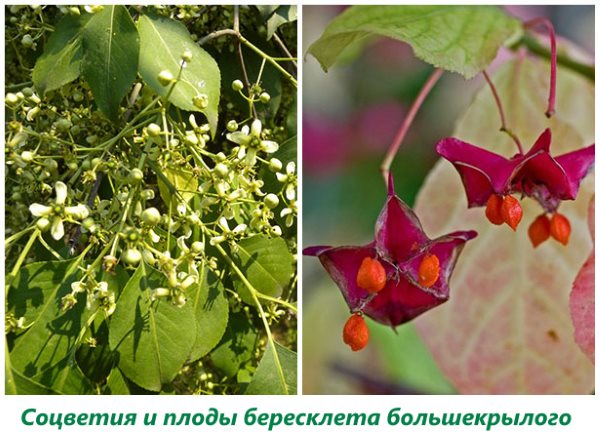

Among the numerous Asian species, the big-winged euonymus stands out for its large capsule fruits, which, when ripe, become densely crimson and effectively open, thanks to the wings up to 1.5 cm long, turning into a kind of bright flower. As you can see in the photo of the euonymus, seeds are attached to the inner side of the fruit, hidden under an orange seed flower.
In the Far East, the homeland of the plant, this species is large deciduous trees up to 9 meters, but in the middle lane the crown height does not exceed 3 meters, and the euonymus looks like a large bush.
Small greenish flowers of big-winged euonymus appear in May and are collected in voluminous branched inflorescences. Seed ripening begins in September, a little later, the color of the smooth ovoid-pointed foliage of the plant also changes. Decorativeness is preserved until a permanent, snow cover is established.
Landing
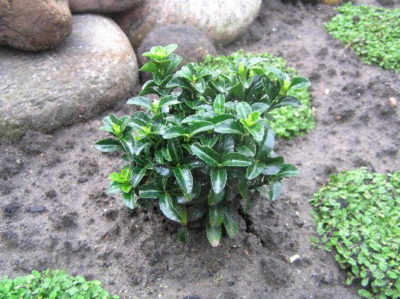

Euonymus is planted in spring or early autumn. It is desirable that the landing site be shaded. We should avoid areas with a high groundwater table. The euonymus grows abundantly, so the site must be chosen at some distance from buildings and trees.
Before planting, you need to properly prepare the soil. Euonymus loves porous, light soil with good water permeability. In case of increased acidity in the soil, liming should be carried out.
A landing hole must be dug in advance, at least two weeks before the scheduled disembarkation date. In volume, it should be one and a half to two times larger than the root system of the seedling.
The bottom of the pit can be drained with sand and a top layer of soil extracted from the pit with the addition of compost.
Next, add a little lime to the pit to lower the acidity of the soil.
Gently lower the seedling into the hole, straighten the roots and fill it with a mixture of soil and compost, gradually tamping it. As a result, the root neck of the euonymus should be flush with the surface of the site.
Immediately after planting, you need to water around the seedling. When the earth subsides, it is worth adding some more of it.
Japanese spindle tree (Euonymus japonicus)
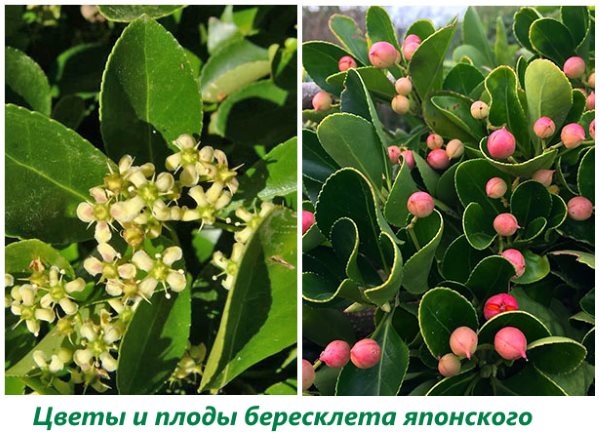

On the islands of Japan, China and Korea, another species of euonymus grows with dense oval leaves and orange seeds in neat pink boxes. This is a Japanese euonymus, reaching a height of 2–8 meters in adulthood.
Plants prefer partial shade, easily tolerate a lack of moisture, and in the second half of May they reveal nondescript whitish flowers with a sour smell. Fruits ripen in autumn.
This type of euonymus is popular as an ornamental plant in many Asian countries, the USA and Europe. For landscaping, dwarf and small-leaved forms, as well as numerous original varieties, have been bred.
The dwarf Japanese euonymus of the Microphyllus variety is used to create hedges and dense borders. The plant tolerates even extensive pruning and easily restores decorativeness.
Cultivars with variegated or yellow leaves also quickly became popular around the world, they adapt well to all types of soil and are easy to care for. An example of a variegated plant is a photo of a spindle tree of the Ovatus Aureus variety with foliage, on which areas of green and bright yellow coexist.
Popular varieties and types of euonymus with photos
Winged Euonymus (Euonymus alatus)... The most important decorative element of this species is the fiery color of autumn foliage, for which the plant received another name "burning bush" or "burning bush".
It is a slow growing, dense and wide shrub up to 2 m in height with rigid, highly branched, brown or greenish straight shoots.
The surface of the shoots is covered with longitudinal, ribbed, cork outgrowths, reminiscent of wings, because of which the plant was named "winged". During the summer, the leaves remain green, and at the beginning of September, literally in a week, they become intensely scarlet. It seems that a fire bush is blazing in the garden.
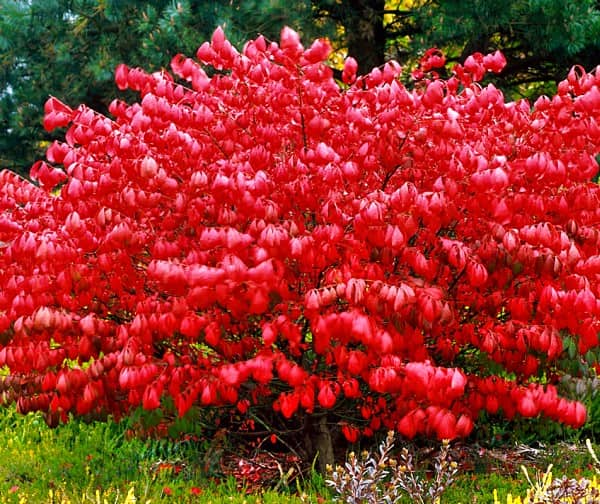

Variety "Compact"
The flowers have no decorative value, but the seed plants of the fruits are colored purple-red, clearly standing out on the bare shoots with the arrival of winter.
"Compact" is the most famous variety of this species with a rounded compact crown and a height of up to 1 meter. Its leaves change color to different shades of red in the fall.
"Fireball" - colorful autumn foliage, the height of the variety is about 1.5 meters, the crown is spherical, compact.
“Rudi Haag” is an extremely low, dwarf variety, up to 0.6-1 m high, with wider “wings” on the shoots and very slow growth.
Euonymus europaeus... It is a tree in the form of a tall bush. The leaves are dark green, and there are also variegated varieties. In autumn they change color to bright red.
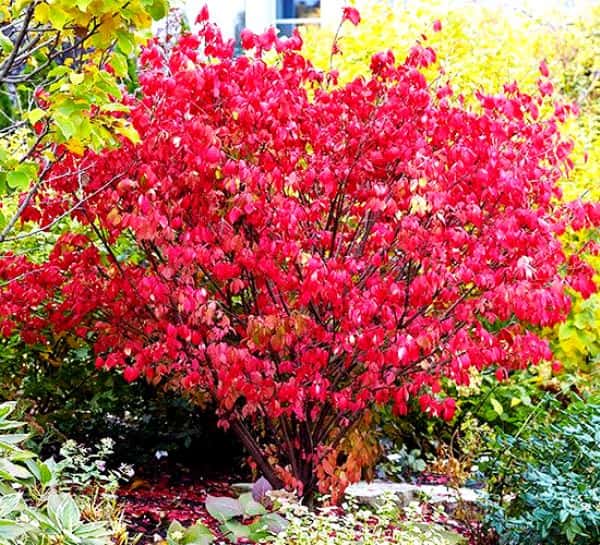

Although not widely used in gardens, this species certainly deserves more attention due to its very decorative fruits of bright pink or red color and colorful fall foliage.
The most famous variety - "Red Cascade" owes its name to the leaves, which turn crimson with the onset of autumn.
Fortune's spindle tree (Euonymus fortunei)... Probably the most decorative and widely cultivated evergreen ground cover species with a huge number of varietal forms and varieties.
The care of Fortune's spindle tree is slightly different from other garden species, mainly due to the form of growth, which is characterized by creeping shoots with shiny, leathery, leaves.
Popular varieties and varieties differ in foliage color and height. Let's list the most interesting of them.
Emerald'n'Gold (Emerald and gold). A bright undersized shrub that is often used in landscaping gardens. In cold winters, golden emerald leaves take on a pinkish tint.
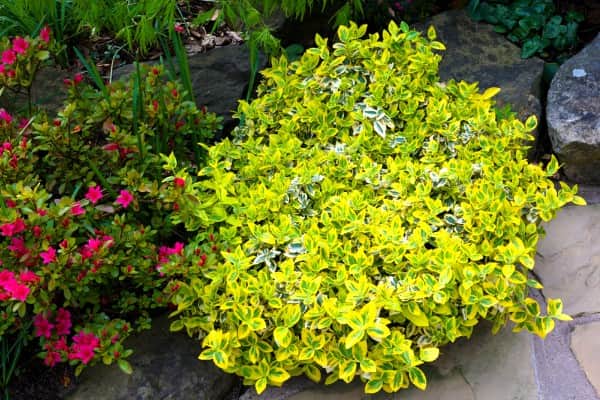

Emerald Gaiety is a wide bush with dark green leaves and a wide white border.
"Sunspot". A small bush up to 30 cm in height with shoots that spread along the ground, forming an attractive yellow-green carpet. The leaves are green with a bright yellow or creamy spot in the middle of the leaf. In winter, they take on a red tint. No pruning is required.
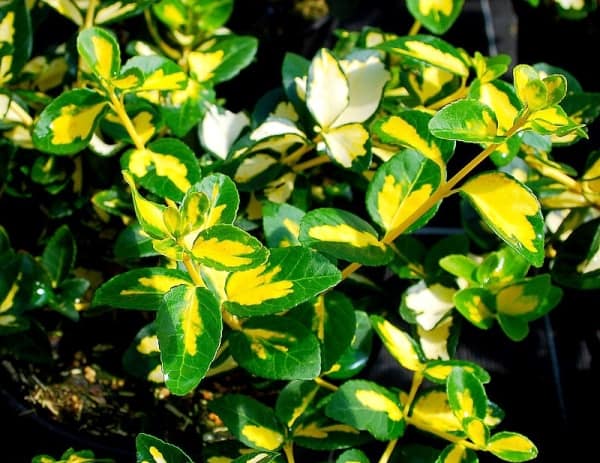

Harlequin is a compact, slow-growing shrub with variegated green and creamy white leaves that turn pink in autumn.


"Sunshine" is a shrub up to 70 cm in height and up to a meter in width. Bright yellow leaves with a green center. It lends itself well to pruning, which allows you to form a compact, rounded crown.
The Silver Queen is a popular and very decorative form with variegated white and green foliage. Its long shoots, reaching 6 meters, can easily trail along the support.
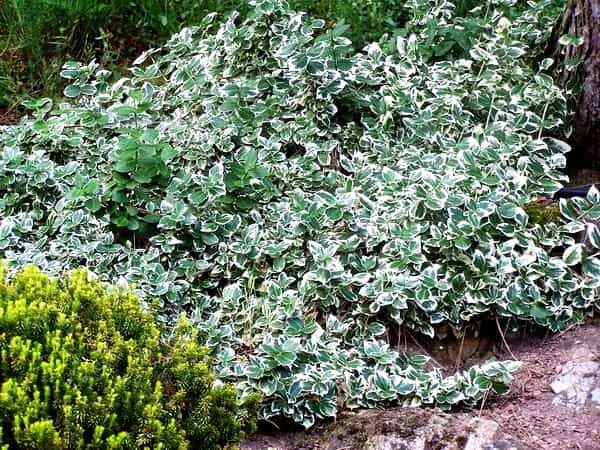

"Silverstone" is a beautiful dwarf shrub 30 cm tall with semi-straight shoots and green-white mottled leaves.
Japanese euonymus... Mainly cultivated as a houseplant. It is characterized by narrow, leathery leaves that can reach up to 7 cm. The shrub is sensitive to cold and needs protection in winter.
"Microfillus" - very similar in appearance to boxwood and also easily amenable to crown formation.
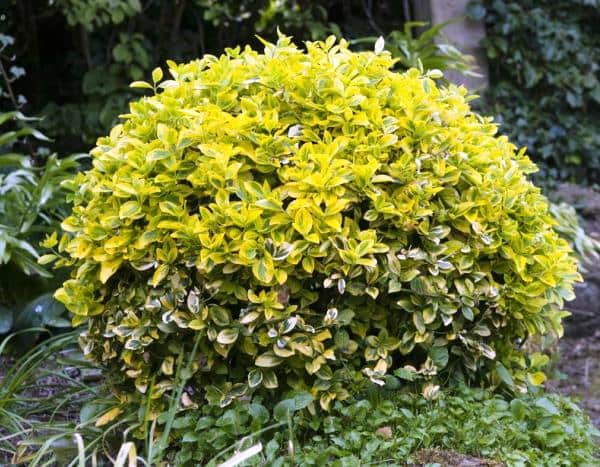

"Bravo" - green and creamy yellow variegated leaves. "Golden Queen" with broad golden-yellow foliage. "Cathy" with variegated white and green leaves.
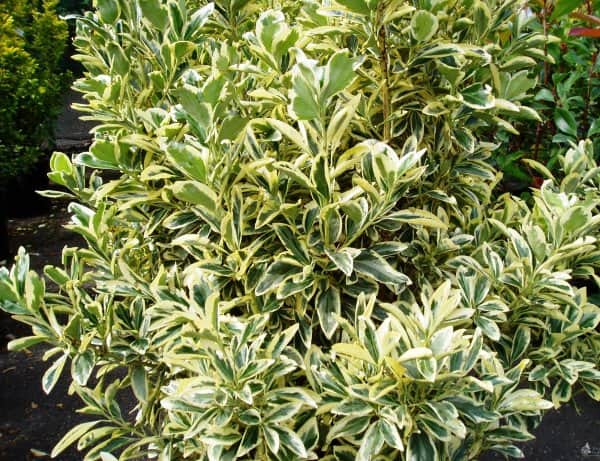

Variety "Silver King" with a compact crown and variegated green-white foliage.
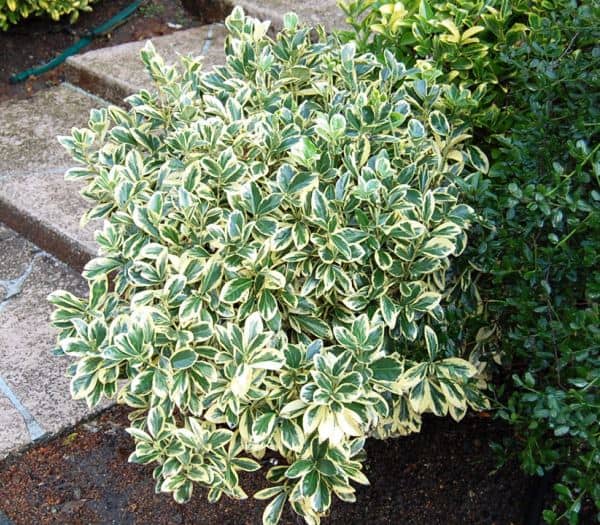

"Aureomarginata" is a variegated variety with green leaves and a white-yellow border around the edges of the leaf.
Warty euonymus (Euonymus verrucosa)
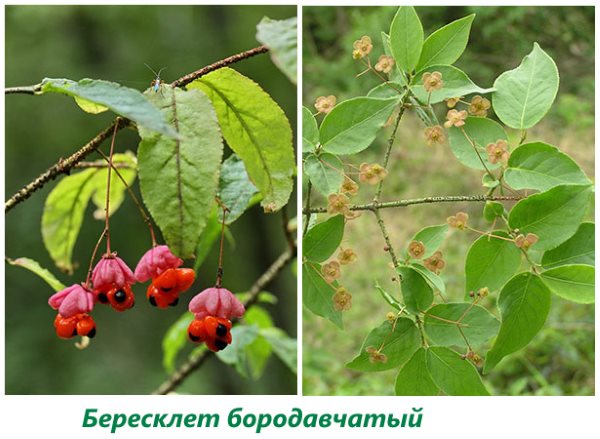

Warty euonymus is one of the indigenous Russian species that can be easily found in the lower tier of deciduous or light coniferous forests. In nature, shade-tolerant plants can reach a height of 6 meters, but more often they look like bushes no higher than 1.5-2 meters.
In the photo of the euonymus, convex growths are clearly visible, covering all the shoots of the plant. Thanks to these formations, similar to warts, the species got its name.
Blossoming of brownish flowers, kept on long petioles, begins in late spring and lasts about a month. Pink fruits with shiny seeds, covered with red-brown seedlings adorn the bushes from August until persistent cold weather. Plants with excellent winter hardiness are suitable for arranging hedges, single and group plantings. This is one of the most affordable and unpretentious types of euonymus, which has been used in landscape design for over 40 years.
Reproduction of euonymus
Most species of euonymus reproduce well vegetatively: by dividing the bush, root suckers, green cuttings. For the latter, in June-July, young, but already quite elastic shoots are chosen. Cuttings 4-6 cm long with one internode are cut from them. They are planted in a greenhouse under a film in a substrate of fertile soil, on top of which sand is poured with a layer of 5-7 cm. Roots develop in 1.5 months.
Seed propagation of euonymus is somewhat more complicated. When sown without stratification and in nature, the bulk of the seeds germinates only in the second spring. Therefore, immediately after collection, the seeds of euonymus should be stratified, for which they are mixed with coarse-grained calcined sand or poorly decomposed moistened sphagnum peat in a ratio of 1: 2. Stratification takes place in two stages. First, euonymus seeds are kept at a temperature of 10-12 ° C for 3-4 months. When the majority (70-80%) of the shell bursts, the temperature is reduced to 0-plus 3 and stored under such conditions for another 4-5 months. To prevent decay, before planting, the seeds should be cleaned of seedlings and pickled in a 0.5% solution of potassium permanganate.
Sow on beds in shallow (about 2 cm) grooves in a substrate of leaf and sod land, humus and sand in a ratio of 4: 1: 2: 1. Seedlings appear in 2-3 weeks. In spring and autumn, it is recommended to mulch euonymus seedlings with peat crumbs with a layer of 3 cm. During the summer, plants are watered and fed with mullein, and covered with spruce branches for the winter. In the 3rd year, they are kept out in a permanent place.
European spindle tree (Euonymus europaea)
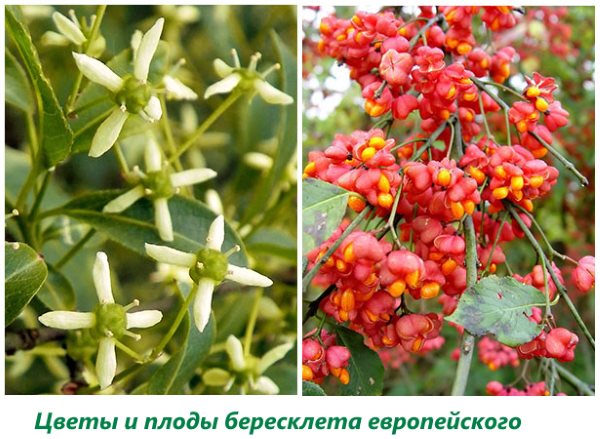

Another species of euonymus, available and often found in its natural habitat, grows in the European part of Russia, as well as in the Caucasus and Crimea. Unlike the previous species, the European euonymus is light-requiring and prefers to settle in deciduous forests.
Under natural conditions, adult specimens reach 6 meters in height, they can look like a small tree or a spreading bush. Plants are easily formed and adapt to urban conditions, so they have long been used for landscaping a variety of objects.
Flowering lasts from June to July, and in the second half of August, the fruits that appear on the branches are painted in maroon and pink tones. The seeds are completely hidden in the tissue of the orange seed plant. The plants in the photo, like all types of euonymus, retain their fruits until the onset of winter. And in the fall, besides them, the bushes are decorated with purple foliage.
Today, gardeners have at their disposal not only traditional plants, but also specially bred forms that differ in the crown and color of the foliage. If you want to plant a European euonymus on your site, you should pay attention:
Correct care
Watering the Euonymus is necessary as the earth dries out. It is recommended to mulch the soil surface around the shrub to keep it moist longer, which will make it easier to care for the plant. You should also loosen the soil around the stem, this will allow moisture to penetrate deeper into the soil, and the root system will be better supplied with oxygen.
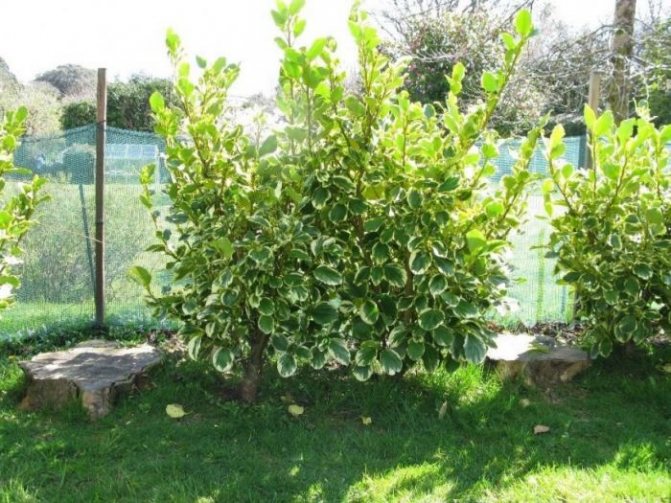

Pouring over shrubs is extremely harmful, therefore, in case of frequent rains, manual watering should be excluded. In order for the plant to develop well, it needs to be fed using mineral fertilizers. This procedure is performed twice a year. The first is done in the spring or summer season, the next in the fall. This is how the planting and care of the Euonymus is carried out.
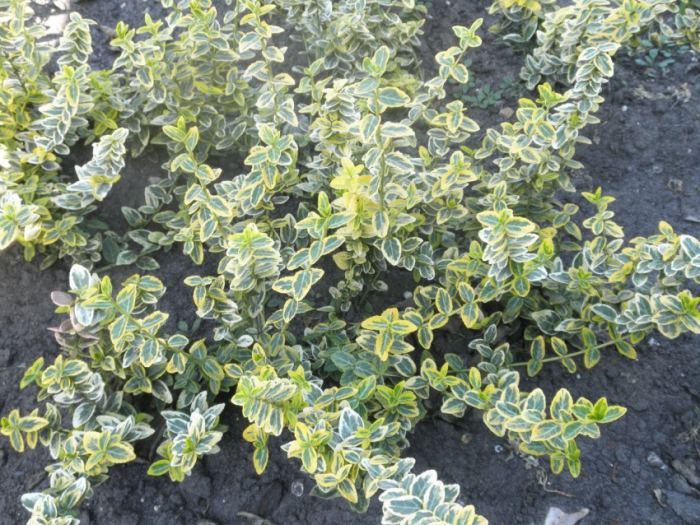

Brief description of cultivation


- Landing... At the very beginning of the spring period or in the fall, during leaf fall.
- Illumination... Green-leaved species grow well in partial shade, and variegated ones need a lot of bright light.
- Priming... It should be slightly alkaline or neutral, light, nutritious and water permeable.
- Watering... Moisten the ground only when necessary. If it rains regularly during the growing season, then the euonymus will not need watering.
- Fertilizer... Top dressing is carried out in early spring and autumn, using a complex mineral fertilizer.
- Pruning... In early spring, or at the end of fruiting, both sanitary and formative pruning are carried out. The crown can be given a conical or ellipsoidal shape.
- Reproduction... By seed method, as well as cuttings, dividing the bush or layering.
- Pests... Spider mites, mealybugs, caterpillars and aphids.
- Diseases... Powdery mildew and trunk rot.
Diseases and pests
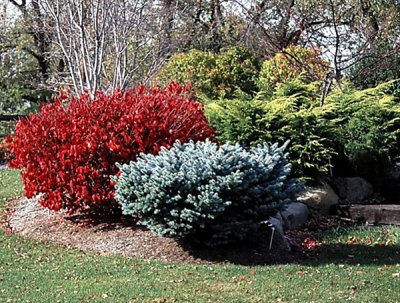

Almost all varieties of this shrub prone to attack by insect pests and diseases.
If necessary spraying with chemicals, then the best time to control and combat pests is the period from mid-spring to early summer.
If the lesion is small, then the infected branches can be cut off.
Powdery mildew is one of the most common fungal diseases.
Usually it is a milky white or gray-brown coating on the top of the foliage, which often causes yellowing, and in more advanced cases, leads to the death of the plant.
The disease is very difficult to track, it is better to immediately take up prevention, it is easier, and ultimately it will be cheaper
IMPORTANT! The bush must receive the required amount of sunlight.
Ensure good air circulation at the planting site and a minimum level of humidity around the foliage. Top watering should be avoided if possible.
In the spring, the shrub should be treated with antifungal agents that can prevent the onset of disease and the appearance of harmful organisms and parasites.
With due diligence in care, since the plant is not the easiest to care for, bereklest will delight you and become a real star on your site, to the envy of your neighbors.
Application in landscape design
Euonymus is considered an unpretentious and frost-resistant plant. It takes root well in new conditions and multiplies easily. Due to its bright autumn appearance, the bush is often planted in landscape design compositions.
The plant will look spectacular in a single planting, as well as with other species in borders, hedges and flower beds. The plant looks especially gorgeous against the background of conifers (spruce, pine, thuja, juniper). The garden takes on brightness and special charm. In alpine slides and rockeries, shrubs go well with other plants.
Bloom
Winged euonymus seems to decorate the garden with bright burning spots. This shrub blooms with completely inconspicuous yellow-green flowers, collected in inflorescences of three to five pieces. The buds have no scent. But the fruits after ripening are a truly bewitching sight. The boxes, hanging on thin legs, are painted in bright shades: from burning orange to deep red. They are immediately striking against the backdrop of green foliage.
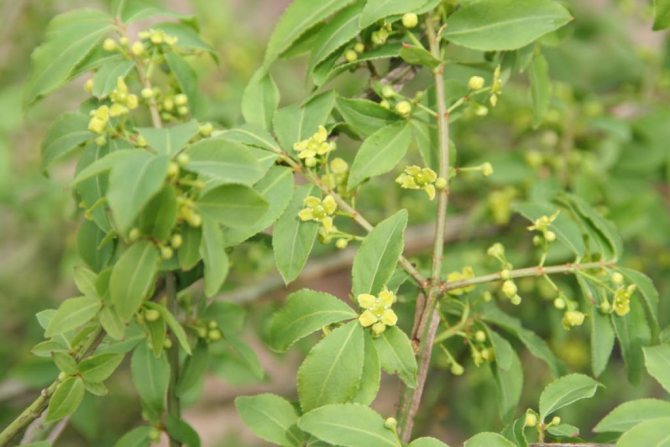

And if during the autumn festival of colors they are hardly noticeable, then after the fall of leaves they continue to stand out with bright spots. Bolls remain on the bush throughout the winter.

